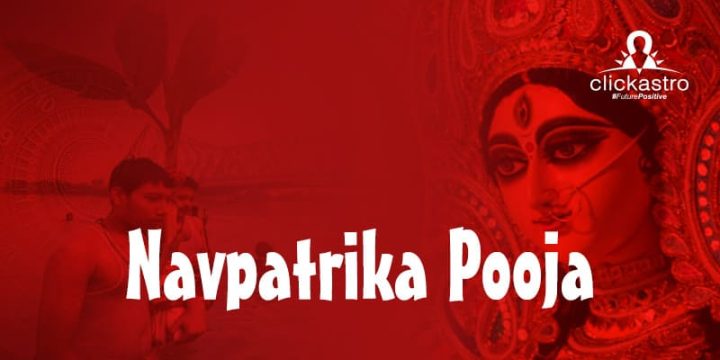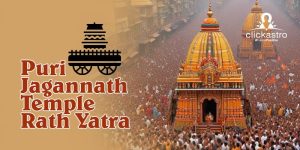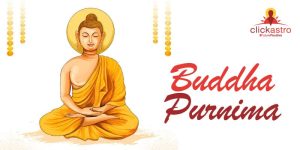Contents[hide]
This sacred ritual, also known as Maha Saptami or Kolabou Pooja, is steeped in symbolism and devotion. The nine plant components in the Navpatrika serve as emissaries of the divine, symbolizing deities such as Brahmani, Kali, Durga, Kartiki, Shiva, Raktadantika, Sokarahita, Chamunda, and Lakshmi. The day commences with the sanctified Mahasnan, culminating in Prana Pratishta and Shodashopachara Pooja, where Goddess Durga is worshiped with sixteen sacred offerings. Especially prominent in the vibrant culture of West Bengal, where it’s known as Kolabou Pooja, Navpatrika Pooja continues to be a cherished tradition that unites devotees in spiritual reverence and celebration.The 2023 Navpatrika Pooja is on Saturday, 21 October.
Saptami Tithi Begins at 23:26:52 on October 20, 2023.
Saptami Tithi Ends at 21:55:15 on October 21, 2023.
In Hinduism, the practice of invoking divine deities often involves the use of mediums or symbols to establish a connection between the mortal world and the spiritual realm. Navpatrika Pooja, celebrated with great reverence, exemplifies this profound tradition. The Navpatrika, a compilation of nine distinct plants, serves as a sacred medium to invoke the spirit of Goddess Durga and her various divine manifestations. Each of these nine plants carries symbolic significance, representing different deities within the Hindu pantheon:
- Banana Tree (Brahmani): The various parts of the banana tree symbolize Goddess Brahmani, who is associated with knowledge and wisdom.
- Kachu Plant (Kali): The Kachu plant is emblematic of Goddess Kali, the fierce and formidable deity who embodies power and transformation.
- Turmeric Plant (Durga): The vibrant yellow turmeric plant signifies Goddess Durga, known for her protective and nurturing attributes.
- Jayanti Plant (Kartiki): The Jayanti plant is representative of Goddess Kartiki, a celestial warrior and symbol of courage.
- Bilva Tree (Shiva): The Bilva tree and its components are dedicated to Lord Shiva, one of the principal deities in Hinduism.
- Pomegranate Plant (Raktadantika): The pomegranate plant embodies Goddess Raktadantika, a deity associated with fertility and abundance.
- Ashoka Tree (Sokarahita): The Ashoka tree and its leaves symbolize Goddess Sokarahita, bringing solace and peace.
- Manaka Plant (Chamunda): The Manaka plant signifies Goddess Chamunda, a fierce protector against evil forces.
- Rice Paddies (Lakshmi): The rice paddies are symbolic of Goddess Lakshmi, the goddess of wealth, prosperity, and fortune.
Rituals and Celebrations
The formation of Navpatrika on Maha Saptami is a sacred and intricate process that signifies the convergence of nature’s bounty in homage to Goddess Durga. Devotees meticulously select nine distinct plants, each symbolizing a unique divine aspect. These plants are lovingly bound together using a branch from the revered Bilva tree, itself a symbol of Lord Shiva. Once the Navpatrika takes shape, it undergoes a purifying ritual. It is bathed in sacred water, symbolizing the infusion of divine energy. Adorned with vibrant orange or red cloth, the Navpatrika radiates with the colors of devotion and spirituality. Placed on a wooden plank beside Goddess Durga, it becomes the focal point of reverence during the auspicious Navpatrika Pooja.
Mahasnan – The Holy Bath:
The day of Navpatrika Pooja commences with the sacred and purifying ritual known as Mahasnan, the Holy Bath. This significant ceremony involves intricate preparations to honor Goddess Durga. A pivotal element is the placement of a mirror in a manner that captures the reflection of the Goddess. This reflection, symbolizing the divine presence, is then ritually bathed with a series of essential offerings. Devotees pour consecrated water, anoint with fragrant oils, and bestow flowers upon the mirrored image of Goddess Durga, cleansing and adorning her divine form. Mahasnan signifies the purification of both the worshipper’s heart and the sanctified representation of the Goddess, fostering a profound spiritual connection.Prana Pratishta and Shodashopachara Pooja:
After the sanctifying Mahasnan, the sacred rituals of Prana Pratishta and Shodashopachara Pooja unfold. Prana Pratishta signifies the consecration and installation of the Goddess’s idol at the designated worship site. It is a moment of great spiritual significance, as it invites the divine presence to inhabit the idol. Subsequently, the Shodashopachara Pooja, a ritual involving the offering of sixteen different sacred items, commences. These offerings, including water, flowers, incense, and more, symbolize deep respect and devotion. Each element signifies various facets of the Goddess’s divine attributes and fosters a profound spiritual bond between the devotees and the deity, creating a moment of divine communion and reverence.Kolabou Pooja in West Bengal:
In the vibrant culture of West Bengal, Navpatrika Pooja takes on a distinct and cherished identity known as Kolabou Pooja. This regional variation adds a unique flavor to the Durga Pooja festivities. Kolabou, affectionately regarded as the wife of Lord Ganesha, assumes a central and revered role in these celebrations. She is symbolically represented as a banana tree, often adorned with traditional attire and jewelry. Kolabou’s presence adds a familial dimension to the festivities, emphasizing unity and devotion within the divine family. West Bengal’s Kolabou Pooja infuses an extra layer of cultural richness and spirituality into the already vibrant tapestry of Durga Pooja celebrations in the region.- Maha Saptami, the auspicious day of Navpatrika Pooja, commences with the sacred Kolabou Snaan, also known as Maha Snaan. This ritual bath is a purifying experience that bestows upon devotees the divine blessings and grace of Goddess Durga, setting the tone for a day of devotion and spiritual connection.
- The Snaan ritual during Navpatrika Pooja involves the meticulous binding together of all nine symbolic leaves. This act of unification symbolizes the convergence of various divine aspects represented by these leaves, infusing them with the collective spiritual energy required for invoking the divine presence of Goddess Durga during this sacred ceremony.
- Post the purifying Maha Snaan ritual, the Navpatrika takes on traditional and culturally significant attire. It is adorned with a white saree that boasts vibrant red borders. This attire adheres to the cherished tradition of Bengal, symbolizing purity, devotion, and the rich cultural heritage of the region during Navpatrika Pooja.
- Following the Maha Snaan and the adornment of Navpatrika, the pivotal Praan Pratishtha ritual unfolds. During this sacred ceremony, the idol of Goddess Durga is reverently placed at the designated worship site. It marks the moment when the divine presence is formally invited to reside in the idol, infusing it with spiritual significance and reverence.
- After Praan Pratishtha, the Shodashopachara Pooja commences, featuring offerings such as water, fruits, flowers, and fragrant sandalwood to honor Goddess Durga’s divine attributes. The ceremony culminates with a grand Maha Aarti, a ritual of profound devotion, followed by the distribution of prasad, symbolizing the sharing of divine blessings with devotees.







